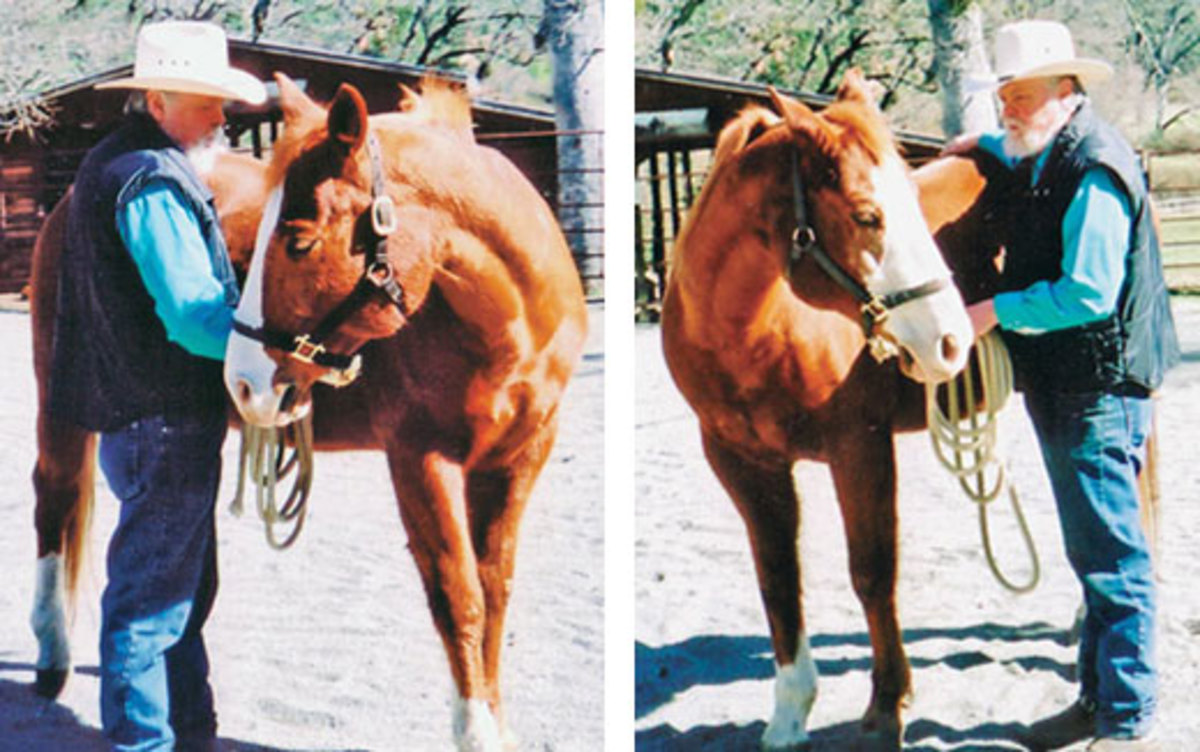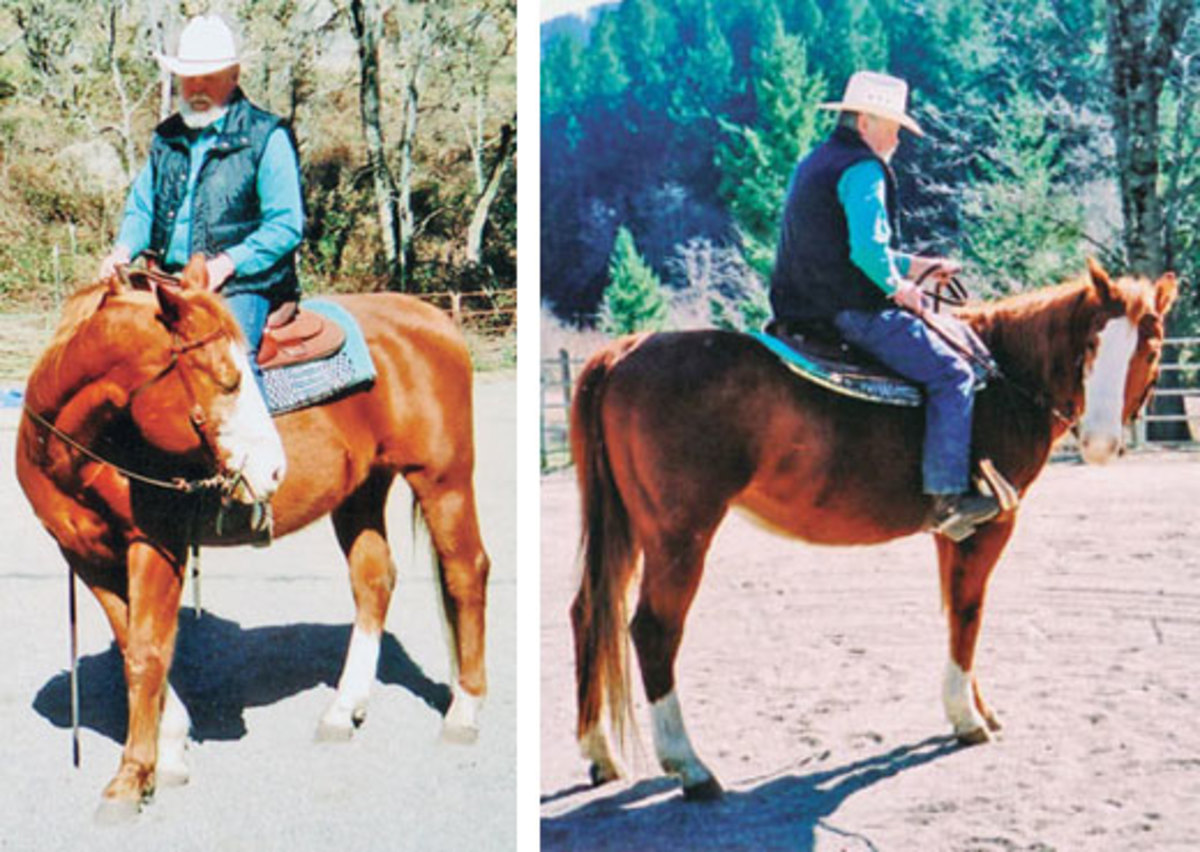Question: My 8-year-old mare tosses her head straight up in the air whenever I apply pressure on the reins to ask her to stop. I don’t think I’m pulling too hard on the reins; she tosses her head even when I apply light pressure. What can I do to correct it?
– Mark Wallis, Dayton, Ohio
Answer: Mark, you’re wise to correct this dangerous behavior. Your mare could toss her head so high, she’ll hit you in the face and can cause an injury. There are many causes of head tossing and head shaking, from bit pain to poor early training to nervousness. Here, I’ll give you several ways to help determine the cause of your mare’s headshaking habit; then I’ll give you an exercise to help correct the habit, if the cause is training-based.
Determine the Cause
Your first task will be to evaluate what might be causing your mare to toss her head. Once you know the cause, it’ll be easier to correct the problem.
First, ask your veterinarian to check your mare’s mouth and teeth to see whether your mare has any physical problems that could be causing her discomfort, which can lead to head tossing.
Also ask your veterinarian to evaluate your mare for a condition called photic headshaking. Horses with this condition experience neuropathic pain (a burning sensation or tingling in the muzzle) due to a chemical imbalance in the trigeminal nerve, a large facial nerve. This condition is often triggered by natural sunlight.
If your mare checks out okay, contact the person who sold her to you (if possible), and get a detailed veterinary, behavioral, and training history. This information will help you get to the source of the problem. For instance, you might learn that your mare was ridden in a harsh bit at an early age and has adopted her head-tossing habit as a way to evade mouth pain.
Now, take these steps to further evaluate the source of your mare’s head-tossing habit:
Check headgear. Ask a Certified Riding Instructor or reputable trainer to evaluate your mare’s headgear. Have him or her check bit type (your bit may be too harsh), as well as bit and bridle fit (poor fit can cause discomfort). You don’t need harsh bits or gimmicks to control your mare. I tell people, “Instead of getting another bit, get a bit of knowledge first.” This may sound a little harsh, but it’s not near as harsh as some bits some people put in their horses’ mouths.
Evaluate your horsemanship. Ask your helper to evaluate your riding style, especially your rein cues. If you ride with tense, heavy hands, or tend to jerk on the reins, your mare will tend to balk. Learn how to give rein cues with a light touch.
Perform ground work. Outfit your mare in a halter and lead rope. As you lead her, see whether she tosses her head from lead-rope pressure alone. If your mare has been taught to longe, longe her, and watch for head tossing. If any pressure on your mare’s head triggers the behavior, I suggest you enlist a reputable riding instructor or trainer to help you.
Step-by-Step Technique
If your headgear and horsemanship check out, and you’ve determined your mare tosses her head only when wearing a bit, then you’re ready to start training your mare to relax and hold her head comfortably and naturally. Note that you’ll be telling her what to do, rather than trying to prevent her undesirable behavior.
First, teach your mare lateral flexion (side-to-side neck flexibility) on the ground. Then teach her lateral flexion and vertical flexion (bending at the poll) under saddle; here’s how.
Step 1: Tack up. For this exercise, outfit your mare in a smooth full-cheek snaffle with copper inlay. With this bit, you can apply lateral and vertical pressure without causing her pain or discomfort – as long as you’re sensitive with your hands. You may use a one-piece loop rein or leather split reins while performing this exercise, whichever is most comfortable for you and your mare.
Step 2: Flex to the left. Lead your mare to an enclosed arena or pen with good footing, and mount up. Ask her to flex her neck muscles by bending her neck between poll and withers. Start with a bend to the left. Slide your left hand down your left rein, and slowly bring her nose back toward her left shoulder. Use steady rein pressure. If you have to apply firmer pressure, do so in a steady, even manner. It may take several sessions to accomplish flexion, but be patient; patience pays off in the long run.
Step 3: Reward the flex. As soon as your mare relaxes – even when she holds her head just a few inches toward the shoulder – release all rein pressure. Praise her in soothing tones, and give her a soft pat on the neck or shoulder.
Step 4: Flex to the right. Now teach your mare to flex to the right by repeating Steps 2 and 3 on her right side.

Step 5: Ask for more flex. As you progress in your flexion training, your goal will be to be able to bring your mare’s nose all the way into her shoulder without any resistance. Advance slowly, be patient, and always end the session on a good note.
Step 6: Ask for vertical flexion. When your mare is flexing laterally, you’ll likely notice she’s also bending a little vertically at the poll. This shows great progress. To teach your mare vertical flexion, ride her in small circles to the left at a walk. As you do, bring her nose a little to the left by sliding your left hand down the left rein and applying smooth pressure. Your mare should flex laterally and also bend her poll, with her nose coming down more toward the vertical. (That is, her head will be more vertically aligned straight up from the ground.) The more your mare bends her poll, the more she’ll drop her head and put her nose in a vertical position.
Step 7: Reward the flex. As soon as your mare drops her head down, release all rein pressure, praise her with soothing tones, and give her a soft pat.
Step 8: Cue for flexion. With these flexion exercises, you’re teaching your mare a cue to relax her head, poll, and neck. Now when she tosses her head (or starts to), you can cue her to relax her neck and poll, and drop her head. It’s a great cue to teach any horse.







